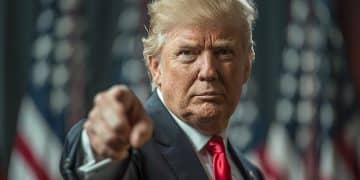Fiscal strategies under the Trump administration: What worked?

Anúncios
Fiscal strategies under the Trump administration, including tax reforms and increased spending, significantly impacted economic growth, income inequality, and federal budget deficits, raising concerns about long-term sustainability.
Fiscal strategies under the Trump administration have sparked much debate. How did these policies influence the economy and affect everyday Americans? Let’s dive into the nuances.
Overview of fiscal strategies implemented
The fiscal strategies implemented during the Trump administration represented a significant shift in economic policy. These strategies aimed to stimulate growth, reduce taxes, and reshape federal spending. Understanding these changes is crucial for analyzing their impact on the economy.
Anúncios
Key Fiscal Policies
One of the main components of the fiscal strategy was the comprehensive tax reform introduced in 2017. This reform lowered the corporate tax rate from 35% to 21%, which aimed to encourage businesses to invest more in the U.S. economy. Alongside tax cuts, there were significant changes to individual tax brackets that were designed to increase disposable income for many Americans.
Budget Cuts and Spending Changes
In addition to tax changes, the administration focused on cutting federal spending in various areas. This included proposed reductions in social programs and a push to reform entitlement spending. Through these measures, the administration sought to reduce the federal deficit and promote fiscal responsibility.
- Corporate tax rate reduction to stimulate investment.
- Changes to individual tax brackets benefiting middle-class families.
- Proposed cuts in discretionary spending and social programs.
The focus on deregulation was also a significant part of this strategy. By reducing the regulatory burden on businesses, the administration aimed to create a more favorable environment for economic growth. This approach was believed to foster job creation and boost the economy.
Anúncios
Throughout this period, there were debates about the effectiveness of these strategies. Proponents argued that tax cuts and deregulation led to economic growth and a robust job market. Critics, however, pointed to increases in federal deficits and the long-term implications for public services and the economy. The interplay between these policies continues to impact discussions on fiscal responsibility and economic strategy in the U.S.
Tax reforms: Key changes and effects
The tax reforms under the Trump administration brought several key changes that aimed to stimulate economic activity and simplify the tax code. Understanding these adjustments is essential for grasping their effects on individuals and businesses.
Major Changes in Tax Rates
One of the most significant reforms was the reduction of the corporate tax rate from 35% to 21%. This move was designed to encourage companies to reinvest their earnings in the U.S. economy. Additionally, the reforms adjusted tax brackets for individuals, leading to lower rates for many taxpayers, especially those in the middle-income range.
Impact on Individuals and Families
The changes also included an increased standard deduction, which simplified tax filing for many Americans. Couples filing jointly saw their standard deduction nearly double, from $12,700 to $24,000. These shifts aimed to ease the tax burden on the average family and encourage spending.
- Corporate tax rate drop to promote domestic investment.
- Increased standard deduction easing tax filing processes.
- Reduced rates for middle-income earners.
However, these tax cuts were not without controversy. Critics argued that while the reforms provided immediate benefits, they could potentially lead to deficits in the long run. The elimination of certain deductions also raised concerns for taxpayers who previously relied on them. Many were particularly affected by the cap on state and local tax deductions.
In the broader context, the tax reforms led to a significant increase in the federal deficit. While the administration touted economic growth and job creation, the long-term sustainability of these benefits came under scrutiny. Debating the effectiveness of these reforms continues, as both supporters and critics assess their lasting impact on the economy.
Impact on federal budget deficits

The impact on federal budget deficits during the Trump administration was significant and has raised important discussions regarding fiscal policy. The tax reforms and increased spending initiatives contributed to a rise in the national deficit.
Rising Deficits
As tax cuts were implemented, the federal deficit grew. By 2019, the deficit reached approximately $984 billion, up from $779 billion in 2018. This growth was partly due to the drop in revenue from corporate taxes and the individual tax cuts, which together reduced the federal government’s income.
Increased Spending
In addition to tax cuts, federal spending increased during this time, mainly in defense and domestic programs. Enhanced military spending was a priority, which added more pressure to the budget. Social programs also saw funding allocations that raised the overall expenditure, contributing to the increasing deficit.
- Tax cuts led to reduced federal revenue.
- Increased defense spending added to budget pressures.
- Overall government spending rose on domestic programs.
The long-term implications of these deficits are still being evaluated. Critics argue that without substantial changes, these rising deficits could harm future economic growth. Increased borrowing may lead to higher interest rates that could negatively impact businesses and consumers.
Supporters, however, maintain that the tax cuts fueled immediate economic growth and job creation. They argue that in the long run, a growing economy will help reduce the deficit. This debate continues to evolve, as new fiscal strategies may emerge to address the complex issue of national debt.
Sector-specific outcomes of fiscal policies
The sector-specific outcomes of fiscal policies implemented during the Trump administration had varied effects across different areas of the economy. Understanding these impacts provides insights into how targeted policies can influence growth in specific industries.
Tax Reforms and Corporate Investments
The reduction in corporate tax rates notably impacted sectors like technology and manufacturing. Companies in these industries gained more capital to reinvest, leading to innovation and expansion. The technology sector, in particular, saw increased funding for research and development (R&D), promoting advancements in areas like artificial intelligence and renewable energy.
Impact on the Energy Sector
Fiscal policies implemented also affected the energy sector significantly. With lower regulations and favorable tax treatments, fossil fuel industries, including oil and gas, experienced growth. This environment stimulated exploration and production activities. However, renewable energy sectors faced challenges due to reduced subsidies, which impacted their growth potential.
- Increased R&D funding in technology driving innovation.
- Fossil fuel industries benefitting from deregulation.
- Challenges faced by renewable sectors due to subsidy cuts.
The financial services sector also saw changes, as tax reforms enabled banks and financial institutions to increase lending. This boost in lending activity supported consumer spending and home purchases. However, some smaller banks and credit unions expressed concerns over increased competition and lower margins.
Lastly, the healthcare sector experienced mixed outcomes. While tax cuts allowed hospitals to invest in infrastructure, changes to insurance regulations raised concerns over access to medical care for some individuals. Balancing the benefits of tax cuts with the need for health services remained a critical discussion.
Long-term implications for the economy
The long-term implications for the economy resulting from the fiscal strategies of the Trump administration are still being analyzed. These policies, including tax cuts and increased spending, have potential lasting effects on economic growth, inequality, and public services.
Economic Growth
One of the primary goals of the fiscal policies was to boost economic growth. Reducing the corporate tax rate aimed to encourage companies to invest and expand. In the short term, many businesses experienced increased profits, which contributed to job creation. However, whether this growth is sustainable remains a key question.
Income Inequality
Tax reforms have also raised concerns about income inequality. While many middle-class families benefited from tax cuts, the wealthiest individuals saw even larger reductions in their tax burdens. This disparity has led to debates about fairness in the tax system and whether it adequately supports lower-income families.
- Increased corporate profits potentially favoring wealthier individuals.
- Concerns about the widening gap between rich and poor.
- The need for reforms to address income equity issues.
Additionally, the increasing federal deficit raises questions about future fiscal sustainability. If the government continues to run high deficits, it might lead to higher interest rates. This situation could dampen investments in critical areas such as education and infrastructure, which are vital for long-term economic health.
Investment in public services may take a backseat if the government prioritizes deficit reduction strategies. This shift could hinder the overall economic growth potential in the future. As the country adapts to these changes, observing how fiscal policy evolves will be crucial in shaping the economy.
FAQ – Frequently Asked Questions about Fiscal Strategies under the Trump Administration
What were the main fiscal strategies implemented during the Trump administration?
The main strategies included significant tax cuts, increased military spending, and deregulation aimed at stimulating economic growth.
How did tax reforms impact economic growth?
Tax reforms aimed to lower corporate tax rates and increase disposable income, which in the short term boosted investments and job creation.
What are the long-term implications of rising federal deficits?
Rising federal deficits could lead to higher interest rates in the future, limiting government spending on public services and infrastructure.
How did these fiscal policies affect income inequality?
While many middle-class families benefited from tax cuts, the wealthiest individuals gained even larger benefits, contributing to concerns about increasing income inequality.





